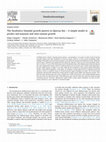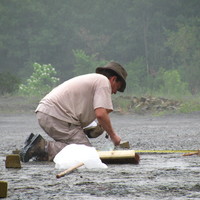Papers by Emilia Gutierrez
EGU General Assembly Conference Abstracts, Apr 1, 2016
AGU Fall Meeting Abstracts, Dec 1, 2018

Science of The Total Environment, Jun 1, 2020
A shift from temperature-limited to water-limited tree performance is occurring at around 60°N la... more A shift from temperature-limited to water-limited tree performance is occurring at around 60°N latitude across the circumboreal biome, in concord with current warming trends. This shift is likely to induce extensive vegetation changes and forest die-back, and also to exacerbate biotic outbreaks and wildfires, affecting the global carbon budget. We used carbon isotope discrimination ( 13 C) in tree rings to analyze the long-term physiological responses of five representative species that coexist in the middle taiga of Western Siberia, including darkneedled, drought-susceptible (Abies sibirica, Picea obovata, Pinus sibirica) and light-needled, drought-resistant (Larix sibirica, Pinus sylvestris) conifers. We hypothesized that droughts are differentially imprinted in dark and light conifers, with stronger 13 C-responsiveness in the latter reflecting a more conservative water use. We found similar Δ 13 C-climate relationships related to the moisture regime of the summer season across species, indicating shared drought responses; however, divergent intrinsic water-use efficiency (WUE i) trajectories from 1950 to 2013 were observed for pines (increasing by ca. 10%) and other conifers (increasing by ca. 25%). These contrasting patterns suggested the passive and active stomatal regulation of gas exchange in these trees, respectively, and led us to discard our initial hypothesis. Discriminant analysis shed light on the climate characteristics responsible for such differential behavior, with years having lower temperatures from May through August (3C colder on average) being responsible for reduced pine WUE i. This finding may be related to the higher plasticity of phenology of pines and the greater susceptibility of fir and spruce to cold damage and heat shock during the early growing season (late April-May). Together with recent negative growth trends and increasing ring-width vs. Δ 13 C coupling, these results indicate the greater susceptibility of spruce and fir, compared with pines and larch, in boreal ecosystems when transitioning from a temperature-to a moisture-sensitive regime.
AGU Fall Meeting Abstracts, Dec 1, 2016

Dendrochronologia, Jun 1, 2021
Abstract Mediterranean tree species have evolved to face seasonal water shortages, but may fail t... more Abstract Mediterranean tree species have evolved to face seasonal water shortages, but may fail to cope with future increases in drought frequency and intensity. We investigated stem radial increment dynamics in two typical Mediterranean tree species, Aleppo pine (Pinus halepensis), a drought-avoiding species, and holm oak (Quercus ilex), a drought-tolerant species, in a mixed forest and on contrasting slope aspects (south- and north-facing). Intra- and inter-annual growth patterns were modelled using the VS-Lite2 model for each tree species and slope-aspect. Both species showed a bimodal growth pattern, with peaks coinciding with favourable conditions in spring and autumn. A bimodal growth pattern is always observed in P. halepensis, while in Q. ilex is facultative, which suggests different strategies adopted by these species to cope with summer drought. More specifically, trees on south-facing slope showed a more evident bimodal pattern and more intra-annual density fluctuations. In recent decades, the intensity of both growth peaks has diminished and drifted away due to the increased summer drought. The VS-Lite2 model reveals a niche partitioning between both species. Differences in growing season’s length and timings of growth peaks in both species are relevant for their coexistence and should be considered for estimating mixed-forest responses under climate change scenarios.
Science of The Total Environment, Feb 1, 2018
• Dendrometers and dendroanatomy are used to compare Aleppo pine growth dynamics. • Trees in the ... more • Dendrometers and dendroanatomy are used to compare Aleppo pine growth dynamics. • Trees in the wetter coastal site show a stronger bimodal growth pattern. • Intra-annual density fluctuations are less frequent in the drier inland site. • Growth bimodality and intra-annual density fluctuations share common climatic cues.

Dendrochronologia, Jun 1, 2018
In Mediterranean climates, bimodal growth patterns, corresponding to two peaks in radial incremen... more In Mediterranean climates, bimodal growth patterns, corresponding to two peaks in radial increment during favorable seasons, have been described in several tree species. However, we lack a better mechanistic understanding of bimodality and its potential responses to the predicted warming and aridification trends. Filling this research gap is important since growth duration affects the capacity of trees to form wood and uptake carbon. Here we used an 11-year (1994-2004) long record of dendrometer data of the Mediterranean Holm oak (Quercus ilex) and compared how climate related to radial increment in trees from the south-and the north-facing slopes. We also related climate variables to tree-ring width and the production of intra-annual density fluctuations (IADFs), which reflects bimodality. In this paper, we introduce a model called VS-Lite2 to simulate tree-growth dynamics, which is a modified version of the process-based Vaganov-Shashkin Lite model. The VS-Lite2 model adequately reproduced the bimodal intra-annual pattern of radial growth, IADFs, and annual tree growth. Trees from the south-oriented slope grew more, produced more IADFs and showed a more marked bimodal pattern than trees from the north-facing slope. These differences agree with the observation that late-summer drought constrained growth. Therefore, radial-growth models should consider plastic bimodality and micro-environmental conditions in areas subjected to seasonal droughts.
Ecosistemas, Aug 22, 2016
Artículo publicado en Open Access bajo los términos de Creative Commons attribution Non Comercial... more Artículo publicado en Open Access bajo los términos de Creative Commons attribution Non Comercial License 3.0. MONOGRÁFICO: El bosque seco neotropical de la provincia Ecuatoriana: un pequeño gran desconocido ecosistemas REVISTA CIENTÍFICA DE ECOLOGÍA Y MEDIO AMBIENTE
Agricultural and Forest Meteorology

Ecological Applications
Tree‐ring data has been widely used to inform about tree growth responses to drought at the indiv... more Tree‐ring data has been widely used to inform about tree growth responses to drought at the individual scale, but less is known about how tree growth sensitivity to drought scales up driving changes in forest dynamics. Here, we related tree‐ring growth chronologies and stand‐level forest changes in basal area from two independent data sets to test if tree‐ring responses to drought match stand forest dynamics (stand basal area growth, ingrowth, and mortality). We assessed if tree growth and changes in forest basal area covary as a function of spatial scale and tree taxa (gymnosperm or angiosperm). To this end, we compared a tree‐ring network with stand data from the Spanish National Forest Inventory. We focused on the cumulative impact of drought on tree growth and demography in the period 1981–2005. Drought years were identified by the Standardized Precipitation Evapotranspiration Index, and their impacts on tree growth by quantifying tree‐ring width reductions. We hypothesized that...

Warmer and drier climatic conditions are projected for the 21st century; however, the role played... more Warmer and drier climatic conditions are projected for the 21st century; however, the role played by extreme climatic events on forest vulnerability is still little understood. For example, more severe droughts and heat waves could threaten quaternary relict tree refugia such as Circum-Mediterranean fir forests (CMFF). Using tree-ring data and a process-based model, we characterized the major climate constraints of recent (1950-2010) CMFF growth to project their vulnerability to 21st century climate. Simulations predict a 30% growth reduction in some fir species with the 2050s business as-usual emission scenario, whereas growth would increase in moist refugia due to a longer and warmer growing season. Fir populations currently subjected to warm and dry conditions will be the most vulnerable in the late 21st century when climatic conditions will be analogous to the most severe dry/heat spells causing dieback in the late 20th century. Quantification of growth trends based on climate scenarios could allow defining vulnerability thresholds in tree populations. The presented predictions call for conservation strategies to safeguard relict tree populations and anticipate how many refugia could be threatened by 21st century dry spells.

Journal of Ecology, 2020
The negative impacts of drought on forest growth and productivity last for several years generati... more The negative impacts of drought on forest growth and productivity last for several years generating legacies, although the factors that determine why such legacies vary across sites and tree species remain unclear. We used an extensive network of tree‐ring width (RWI, ring‐width index) records of 16 tree species from 567 forests, and high‐resolution climate and normalized difference vegetation index (NDVI) datasets across Spain during the common period 1982‒2008 to test the hypothesis that climate conditions and growth features modulate legacy effects of drought on forests. Legacy effects of drought were calculated as the differences between detrended‐only RWI and NDVI series (i.e. after removing long‐term growth trends) and pre‐whitened RWI and NDVI series predicted by a model including drought intensity. Superposed Epoch Analysis (SEA) was used to estimate whether legacy effects differed from random. Finally, legacy effects were related to water balance, growth persistence and var...

Ecological Indicators, 2020
This study links tree-ring growth and gross primary production for a variety of forest types unde... more This study links tree-ring growth and gross primary production for a variety of forest types under different environmental conditions across Spain. NOAA-AVHRR satellite imagery data were combined with dendrochronological records and climate data at a fine spatial resolution (1.21 km 2) to analyze the interannual variability of tree-ring growth and vegetation activity for different forest biomes from 1981 to 2015. Specifically, we assessed the links between tree-ring width indices (TRWi), the Normalized Difference Vegetation Index (NDVI) and a variety of environmental conditions, represented by climatic variables (air temperature, precipitation, evapotranspiration and water balance) and elevation. The impact of these variables on tree growth was assessed by means of the Predictive Discriminant Analysis (PDA). Results reveal a general positive and significant relationship between inter-annual variability of the NDVI at a high spatial resolution (1.21 km 2) and tree-ring growth. Maximum correlations between NDVI and tree-ring growth were recorded when cumulative NDVI values were considered, in some cases covering long time periods (6-10 months), suggesting that tree growth is mainly related to Gross Primary Production (GPP) at annual scale. The relationship between tree-ring growth and inter-annual variability of the NDVI, however, strongly varies between forest types and environmental conditions.

Global Change Biology, 2019
The mechanisms translating global circulation changes into rapid abrupt shifts in forest carbon c... more The mechanisms translating global circulation changes into rapid abrupt shifts in forest carbon capture in semi‐arid biomes remain poorly understood. Here, we report unprecedented multidecadal shifts in forest carbon uptake in semi‐arid Mediterranean pine forests in Spain over 1950–2012. The averaged carbon sink reduction varies between 31% and 37%, and reaches values in the range of 50% in the most affected forest stands. Regime shifts in forest carbon uptake are associated with climatic early warning signals, decreased forest regional synchrony and reduced long‐term carbon sink resilience. We identify the mechanisms linked to ocean multidecadal variability that shape regime shifts in carbon capture. First, we show that low‐frequency variations of the surface temperature of the Atlantic Ocean induce shifts in the non‐stationary effects of El Niño Southern Oscillation (ENSO) on regional forest carbon capture. Modelling evidence supports that the non‐stationary effects of ENSO can be...

Quaternary International, 2018
Climate reconstructions based on tree-ring features rely on the assumption that growth drivers ar... more Climate reconstructions based on tree-ring features rely on the assumption that growth drivers are mainly meteorological variables. Consequently, annually resolved and absolutely dated temperature reconstructions in high-elevation conifer forests are mainly based on tree-ring width (TRW) and maximum wood density (MXD). However, long-term and annually resolved chronologies of chemical elements are scarce despite they could complement TRW-and MXD-based reconstructions. Here, we used a novel non-destructive method by applying Micro X-ray fluorescence (µXRF) to wood samples of old mountain pine (Pinus uncinata) trees from two Pyrenean high-elevation forests. We tested if Calcium (Ca) relative concentration, as estimated through µXRF, is a valuable proxy of long-term climatic and environmental changes in two sites with basic and acid soils, respectively. We compared the climate sensitivity of TRW, MXD and Ca by using calculating correlations with monthly climate data (mean temperature and total precipitation). Then, we built linear regressions to predict temperatures for the period 1900-2009. Prior-autumn and spring temperatures were positively related to TRW, MXD and Ca. However, Ca series revealed a high sensitivity to temperatures during the prior winter and spring but also to summer precipitation. We confirm the potential of long-term wood-chemistry studies based on the µXRF non-destructive technique to reconstruct environmental changes.










Uploads
Papers by Emilia Gutierrez